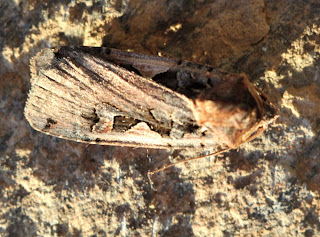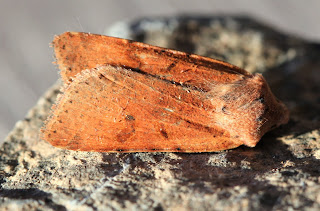I was once again up around 7am as I wanted to enjoy the serenity of being at Seacrest and also because I was excited to check the Moth trap and trail camera I had set up the previous night.It was overcast and very fine rain was falling but I was straight out to the moth trap.
Crane Flies were everywhere, at least 30 of them inside the moth trap and more covering the fences and plants.Not a major interest to me but it showed the abundance of food available to our feathered friends, mainly a male Blackbird and a Robin which were happily bouncing about the decking enjoying a protein full breakfast.There were quite a few Moths with Marbled Carpets and Large Yellow Underwings being the most numerous.Square-spot Rustic,Beaded Chestnut, Lunar Underwing, Straw Dot, Snout, Setaceous Hebrew Character and Garden Carpet were also among the egg trays in the trap.
Snout
Setaceous Hebrew Character
Square-spot Rustic
Lunar Underwing
Garden Carpet
Marbled Carpet
Beaded Chestnut
The most intriguing Moth though was, what I thought a well marked Rush Veneer.After asking a few Lepidopterists on social media it was suggested it could possibly be a Lucerne Moth(Nomophila Nearctica).An American moth that had maybe been blown in by the oncoming storms and a species with no confirmed record of it in Europe.Unfortunately without further examination of the Moth we will never be able to confirm it's true identity.
The Rush Veneer or potential Lucerne Moth
Finishing with the Moths I then removed the SD card from the trail camera and was excited to find it had recorded three times during the night.The first 2 clips were of nothing but the third featured a quick pass of a jumping Mouse.
Our plan for the rest of the day(once Majella had woken up) was to explore the headland on the opposite side of Mount's Bay, the Lizard Peninsula.It was just a 20 minute drive around Penzance and into Marazion where we parked to walk to St. Michael's Mount.
At low tide the causeway is exposed giving you access to walk over and explore this island community.The receding tide had unveiled a myriad of food that Gulls, Oystercatchers and Little Egrets were taking advantage of.
Little Egret
Young Herring Gull with a Starfish
Mute Swans with Oystercatcher in the foreground
We crossed the causeway and explored the village and harbour while learning about the history of this ancient island parish.The castle watching over the neighbouring island and bay was stunning, now a family home, it had been a monastery and a battle sieged fort in it's past.
The view of Mousehole across Mount's Bay from St. Michael's Mount
We grabbed a coffee in the island cafe and headed back to the mainland before the encroaching tide swallowed the causeway once more.
A quick walk through Marazion brought to us this fabulous Dolphin water feature which I photographed with St.Michaels behind.
There were a few coves we wanted to check out and so decided to begin at the most Southern end and work our way back.Onwards to Lizard Point.
Britain's Southern most point reaching out into the Atlantic Ocean.
We sat on the cliff top watching Great Black-backed Gulls, Lesser Black-backed Gulls and Jackdaws glide by on the Ocean breeze.Atlantic Grey Seals swam in the water below, occasionally stopping, head skyward as if watching the Human circus up on the cliffs or maybe silently pleading with us to halt the destruction of their home.
We ate at the most Southern cafe in Britain along with the House Sparrows who were intent on longingly staring at your food like feathered Dogs while inches away from our plates.Our original plan was to also visit Kynance & Mullion coves but we just lost track of time relaxing and marvelling in the Natural beauty before us.I did however get one last close encounter with the beautiful Cornish Chough ;)
As we were losing daylight we decided to head back North along the peninsula to Marazion and have a quick walk around the RSPB Marazion Marshes.When we arrived the tide had risen and now covered the causeway to St. Michael's Mount.
Marazion Marshes
One roadside pool at the reserve held numerous Moorhen, Mute Swans, Little Egrets, a Little Grebe and a Grey Heron, while a walk through the scrub revealed Robins, Blackbirds and more amazing Stonechat sightings.It was a wonderful way to end another day exploring the stunning South West coastline.
It was time to head back to Seacrest and pack for our 400 mile journey back North.Cornwall is such a beautiful part of the country with so many places to explore and wildlife to see and we feel just so privileged to have been able to stay in such amazing accommodation at Seacrest.
We cannot thank Alexia enough for giving us this opportunity to experience Cornwall.She is a special person, a massive voice for Wildlife and a Trustee of The Wildheart Trust.
Our final Cornwall Sunrise as seen from Seacrest in Mousehole.
Thank you again for reading and browsing through my photos :) I hope you enjoyed it a little bit.It is very much appreciated :)

























No comments:
Post a Comment